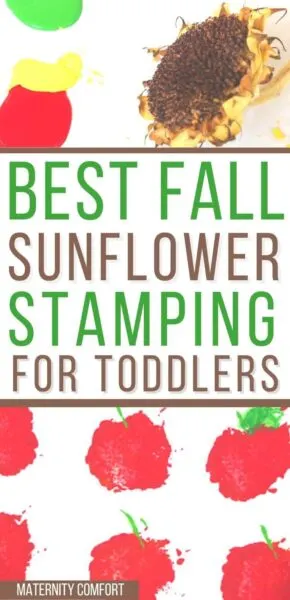Updated February 9, 2023
The months of September, October, and November provide us with so many beautiful autumn days.
But, that also means lots of days that we need to come up with activities for our very active toddlers.
Today I’m sharing a super simple art activity: fall sunflower stamping for toddlers.
Our kids wanted to use the dried sunflowers to make apples.
We are in apple season here in New England and everything is apples, apples, apples.
So the directions I’m sharing are for using the sunflowers for stamping apples.
You can totally do this as a 100% process art project by using multiple paints, dried sunflowers, and let your toddler stamp to their heart’s content.
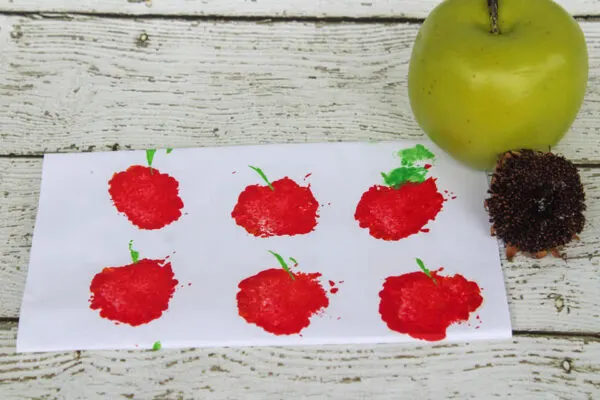
Yet another amazing, simple arts and crafts project for you and your toddler, this Fall Sunflower Stamping project is absolutely lovely!
This rather unique take on simple stamping uses the dried top of a sunflower to print the paint onto the paper, as opposed to something like a cork.
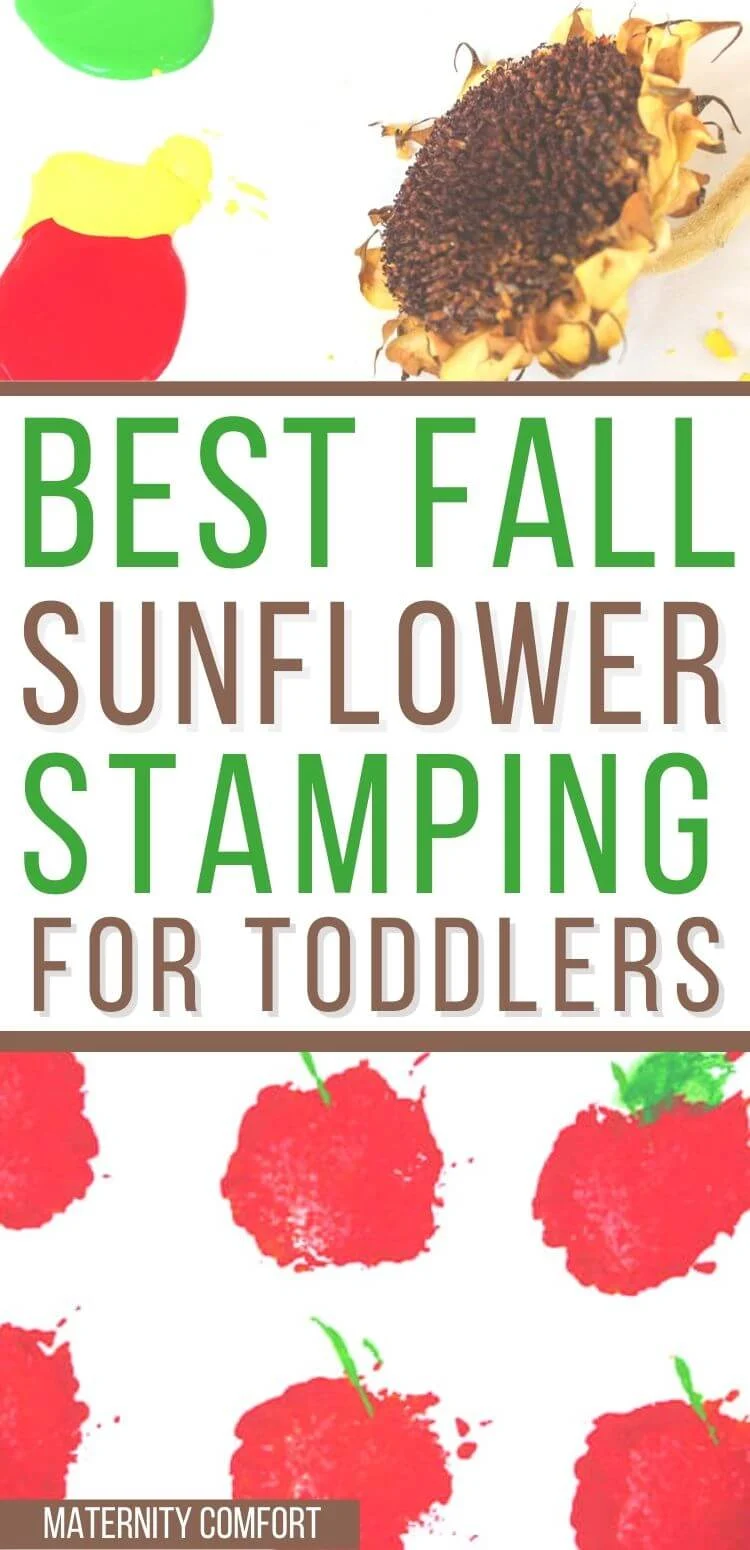
Let’s jump into the supplies and directions for this easy toddler craft for fall.
Fall Sunflower Stamping For Toddlers
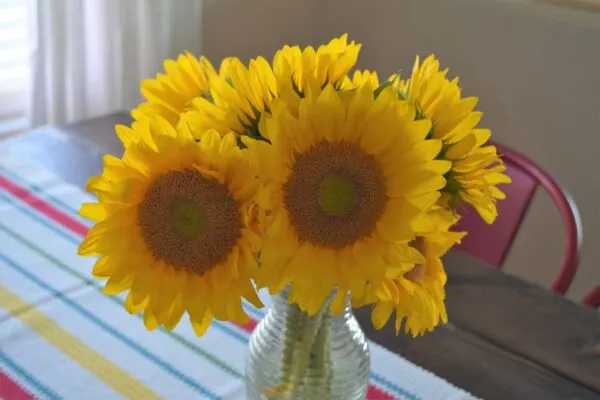
Photo: Maternity Comfort Solutions
For this project, we chose to use a classic red apple which fits the fall theme really well!
The simple supply list, perfect fall-theming, and huge pile of fun make this an amazing choice for a fall arts and crafts project.
If you’ve been looking for something to help get your toddler in the fall spirit, this quick and easy project is a great choice!
Supplies:
A Dried Sunflower that has lost the petals
Red, green, and yellow paint
A paper plate
A sheet of paper
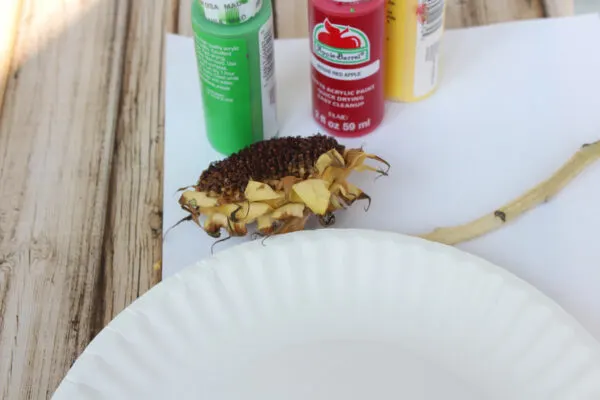
Directions:
Pour a quarter-sized drop of red paint onto a paper plate.
Add a little yellow paint to the edges of the red paint.
Pour a dime-size drop of green paint onto the plate.
Remove one of the leaves that remain on the flower stem and set it aside.
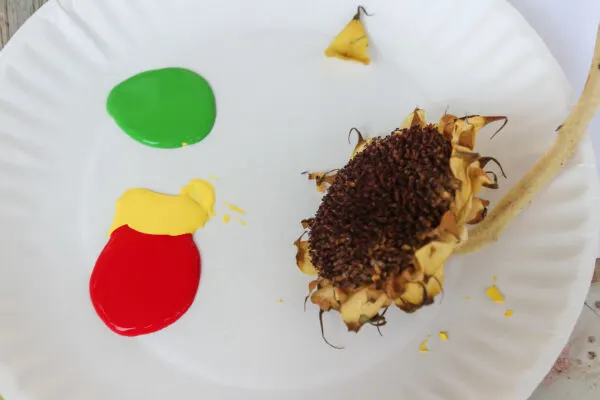
Offer the sunflower head to your child.
Encourage them to dip into the red/yellow paint and press it onto the paper.
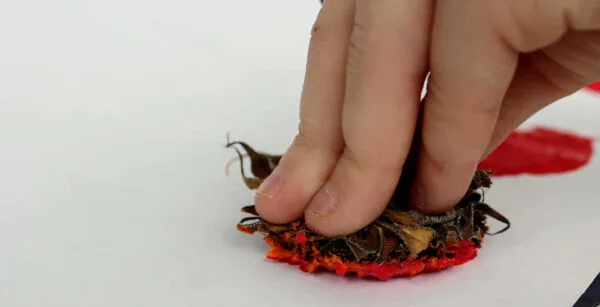
After your child is done stamp painting, take the leaf that you set aside and dip it into the green paint.
Press the leaf into the top of each ‘apple’ to create a stem.
Allow to dry and display.
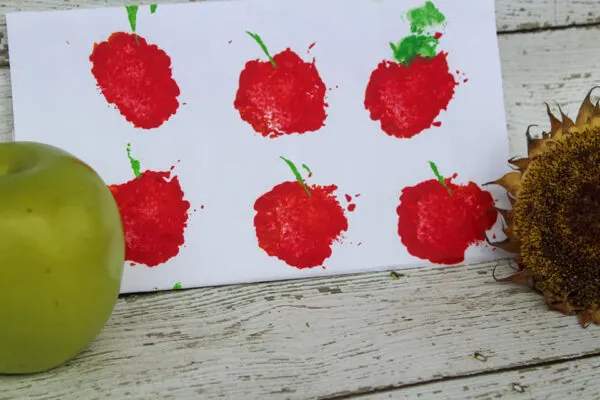
We always try to tie our activities into literature.
You want your toddler to develop a love for reading.
The best way to do that is to read to them every day.
Let them see you reading and enjoying books, magazines, and journals.
These are some of our kid’s favorite books about apples:
Art and crafts for toddlers have a vast range of benefits that surpass the fact that it keeps them entertained.
Young children enjoy drawing, painting, coloring, and creating models.
However, in many circumstances, they can get frustrated by the fact that they often fail to produce precisely what they had visualized in their heads.
This can happen with toddlers and pre-schoolers when they do product-oriented arts and crafts.
Their creation doesn’t look exactly like the sample you made for them to follow.
That said, it is better to allow young toddlers and preschoolers to explore a wide range of open-ended art experiences.
This is now “process art.”
Process art has a range of benefits for a toddler, and therefore parents and preschool teachers should emphasize this art.
Keep reading to learn more about process art and how it differs from product art.
Why is process art important for toddler development?
Process art is important for toddlers because it helps them develop a wide range of necessary skills.
Young children can develop in coordinating their motor control skills, self-identity skills, cognitive skills, problem-solving skills, comparison skills, and emotional maturity.
Process art helps toddlers explore their creativity and encourages them to be inquisitive.
In addition, process art helps toddlers develop good relationship skills as they relate and collaborate with other children to play art.
Process art helps children expand their vocabulary and helps them become comfortable sharing their ideas verbally.
What is process art?
Now you know what process art does to a toddler’s development, the next question that hits your mind “What is process art?”
Process art is simply art that does not focus on the end product but rather on the activities leading to the product.
In this regard, process art focuses on the imagination of the child seen in their creative process rather than the results obtained.
In addition, process art has some characteristics that differentiate it from other forms of art.
This art is more experimental, open-ended, creative, unstructured, and self-motivated.
Naturally, children are attracted to art and usually perceive it as the best form of expression as they uncover different possibilities and explore many materials of different types.
As a parent, you need to lead and guide your toddler in process art and observe how the toddler manipulates the available objects.
As a result, you will better understand your child’s ability and provide help in case of need.
An artist named Robert Morris invented the term Process art when he was working in a Museum in the year 1968. He started experimenting with soft felt by celebrating how it impacted stress.
He had a simple task: he cut and dropped pieces of felt scraps on the floor, making it colorful. This art is also referred to as Post-Minimalist or Anti- Form art.
Process art is instrumental in children learning because it allows young children to realize, explore and expand on creativity in unrestricted means.
In this kind of art, we have minimal work as we only provide the essential materials.
We don’t need to give verbal instructions nor engage in creative activities with our toddlers.
As parents, we also observe keenly how the toddlers manipulate the available tools.
Why is process art important to toddlers and preschoolers?
Toddlers and preschoolers are called immature because of their physical body structure and cognitive and creative abilities.
Process art has a significant impact on the behavior of toddlers and preschoolers.
As a parent, you should incorporate process art activities to make learning more effective.
Here are different ways in which process art is important to both toddlers and preschoolers.
1. Development of motor skills.
Preschoolers enjoy it more when they engage in motor activities.
Process art helps learners to develop refined skills like cutting, painting, gluing, and coloring.
2. Development of cognitive skills.
Process art helps in the development of the cognitive aspect of a child.
For example, a child who plays with different colors and paints can easily differentiate, compare, plan and solve specific fundamental problems.
3. Nurture socio-emotional health.
Art, in general, helps toddlers to focus on their self-esteem and actively share their ideas.
4. Build verbal skills.
Some children tend to fear talking in groups, but they can practice it if they are encouraged to share or explain their art pieces.
When toddlers are allowed to communicate their art experiences verbally or ask questions, they get more confidence and gain more verbal skills.
If you are a parent or a caregiver of toddlers, there are some things that you should do and others that you should not.
First, do not be tempted to give the toddlers a model to copy from.
In addition, you should never discourage toddlers and preschoolers from trying their ideas unless they are about to harm themselves.
As long as they won’t get hurt or won’t hurt anyone or anything else, let them try things.
How to encourage process art at home:
1. Set aside adequate time: as earlier seen, process art requires more time, so the time should be planned adequately.
All the material that might be needed should be first gathered and readied.
As a parent, notify your child that it is time for art and provide the material.
Then, relax and watch your toddler create.
2. Let the work be child-driven: Allow the child to create models and label or paint them all by themself.
Do not direct the child on what to do or tell them what you expect.
Allow your toddler to lead wherever the art takes them.
3. Forget about getting it right.
Allow the toddlers to take risks and make as many mistakes as possible.
The child’s method to identify some of these mistakes and correct them will help you determine their ability to handle problems.
We hope you find inspiration in our fall sunflower stamping for toddlers.
It isn’t easy keeping an active and curious toddler busy.
Fall art activities for your toddler do not need to be complicated or expensive!
This is a fun activity to do after visiting an apple orchard or state fair.

